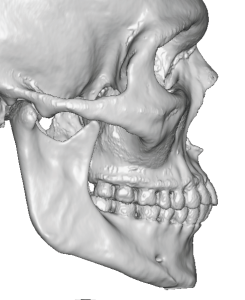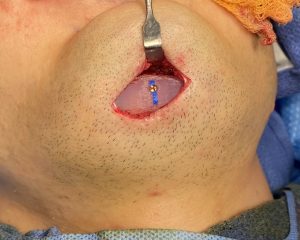Background: The most frequent implant augmentation of the face is the chin. As only one of two solitary projecting structures of face (the nose is the other) a visible and proportionate chin shape has long been recognized as an important aesthetic facial feature. As a result chin augmentation has been practiced for half a century and is still a popular aesthetic procedure today. (even if injectable fillers have exceeded in number that of implants) It remains as the most frequently performed facial implant across numerous surgical specialities who work on the face.
Because of its common performant it is very common for patients seeking jawline augmentation to have first had a chin implant. Knowingly or unknowingly the chin implant is often a stepping stone to a more complete jaw augmentation. The presence of a chin implant provides invaluable information for the custom jawline implant design. It can be seen in the 3D CT scan needed for the implant design if it is a silicone, ePTFe or PEEK material. (Medpor material can rarely be seen) Its visibility allows the implant’s position on the bone and its dimensions to be known which helps determine the new dimensions of the chin portion of the jawline implant design.
Less well known is the impact of the chin implant on the bone is also useful information. As the implant is digitally removed for the jawline implant design (no need to remove it for the design) its impact on the bone can be seen from the depth of imprinting, the location of bony overgrowths (that will need to be removed) as well as the location of the implant wings to the mental nerves.




Key Points:
1) Chin implants are a frequent precursor to the design and placement of a custom jawline implant.
2) The existing chin implant provides significant information for the custom jawline implant design.
3) The chin portion of the custom jawline implant is the critical initial positioning and fixation of the custom jawline implant.
Dr. Barry Eppley
World-Renowned Plastic Surgeon








